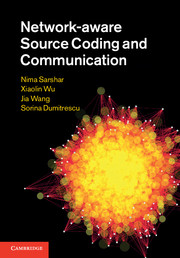Book contents
- Frontmatter
- Contents
- 1 Introduction
- Part I The lossless scenario
- Part II The lossy scenario
- 5 Lossy source communication: an approach based on multiple-description codes
- 6 Solving the rainbow network flow problem
- 7 Continuous rainbow network flow: rainbow network flow with unbounded delay
- 8 Practical methods for MDC design
- 9 Using progressive codes for lossy source communication
- 10 Lossy communication of multiple correlated sources
- References
- Index
5 - Lossy source communication: an approach based on multiple-description codes
from Part II - The lossy scenario
Published online by Cambridge University Press: 07 October 2011
- Frontmatter
- Contents
- 1 Introduction
- Part I The lossless scenario
- Part II The lossy scenario
- 5 Lossy source communication: an approach based on multiple-description codes
- 6 Solving the rainbow network flow problem
- 7 Continuous rainbow network flow: rainbow network flow with unbounded delay
- 8 Practical methods for MDC design
- 9 Using progressive codes for lossy source communication
- 10 Lossy communication of multiple correlated sources
- References
- Index
Summary
In Part I of this book, we investigated the problem of lossless source communication in networks. We reviewed the current literature, with an emphasis on new results in network coding. This chapter is the beginning of Part II, which deals with the case of lossy source coding and communication, where we allow imperfect reconstruction of sources at receivers.
There are two cases where such lossy extension to network information flow problems are required/necessary. For one, most multimedia signals, such as audio, video, and images, simply cannot be encoded losslessly. The digitization process is, by nature, lossy. With multimedia signals claiming the largest share of the traffic in today's Internet, the study of lossy network communication is particularly important. Second, lossless communication implies that the same information content has to be delivered to all receivers (the so-called common information multicast). For most multimedia applications, different classes of receivers with different bandwidth resources are often interested in consuming the same multimedia content. In such heterogeneous network environments, one might consider communicating different encodings of the same content to different receivers, such that the receivers with higher bandwidths are able to reconstruct the signal at a higher quality. The concept of quality, and the tradeoff between the rate and distortion, are the defining characteristics of lossy network communication.
In this chapter, we introduce a number of techniques that allow one to optimize the quality of delivered multimedia signals to receivers over a heterogenous network application.
Information
- Type
- Chapter
- Information
- Network-aware Source Coding and Communication , pp. 39 - 58Publisher: Cambridge University PressPrint publication year: 2011
